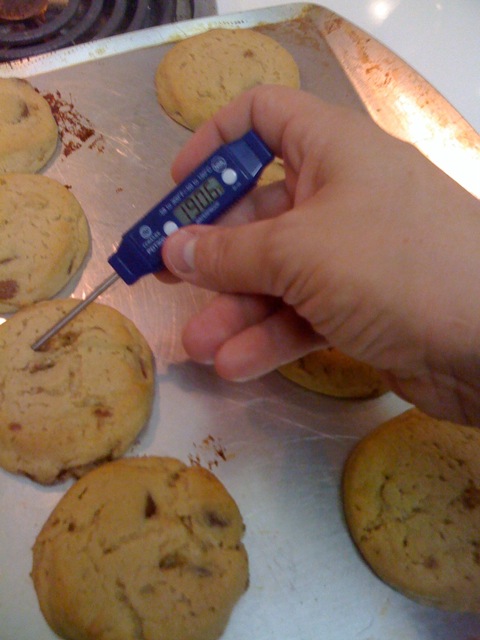I cringe when someone says, ‘food safety is simple.’
A review of existing studies by the U.K. Food Standards Agency found that, although people “are often aware of good food hygiene practices, many people are failing to chill foods properly, aren’t following advice on food labels and aren’t sticking to simple hygiene practices that would help them avoid spreading harmful bacteria around their kitchens.”
Yes, individuals are impervious to risk; been known for decades.
And there’s that word, ‘simple’ again.
I especially cringe when someone says, ‘cooking a hamburger is easy with these simple food .jpg) safety steps.’
safety steps.’
Ho Phang and Christine Bruhn report in the current Journal of Food Protection that in video observation of 199 California consumers making hamburgers and salad in their own kitchens, handwashing was poor, only 4% used a thermometer to check if the burger was safely cooked, and there were an average of 43 cross-contamination events per household.
There’s some good data in the paper about what consumers do in their own kitchens, and the results are an additional nail in the self-reported-food-safety-survey coffin: people know what they are supposed to do but don’t do it.
But what the paper doesn’t address is how to influence food safety behaviors. Instead, the University of California at Davis authors fall back on the people-need-to-be-educated model, without out providing data on how that education – I prefer compelling information – should be provided.
The authors state:
• educational materials need to emphasize the important role of the consumer in
preventing foodborne illness and that foodborne illnesses can result from foods prepared in the home.;
• the gap between the awareness of the importance of hand washing and the actual practice of adequate hand washing should be addressed by food safety educators.
• food safety educators should address the lack of reliability of visual cues during cooking (stick it in — dp);
• food safety educators should emphasize faucet cleaning with soap and water as a way of preventing cross-contamination; and,
• ignorance about food irradiation point to a further need for education.
The authors do correctly note that program to promote the use of thermometers when cooking .jpg) burgers, initiated by the introduction of Thermy in 2000, has not been successful. So why do more education?
burgers, initiated by the introduction of Thermy in 2000, has not been successful. So why do more education?
And the E. coli O157:H7 outbreak in Jack-in-the-Box hamburgers happened in Jan. 1993, not 1994 as stated in the paper; someone should have caught that.
Burger preparation: what consumers say and do in the home
01.oct.11
Journal of Food Protection®, Volume 74, Number 10, October 2011 , pp. 1708-1716(9)
Phang, Ho S.; Bruhn, Christine M.
http://www.ingentaconnect.com/content/iafp/jfp/2011/00000074/00000010/art00017
Abstract:
Ground beef has been linked to outbreaks of pathogenic bacteria like Escherichia coli O157:H7 and Salmonella. Consumers may be exposed to foodborne illness through unsafe preparation of ground beef. Video footage of 199 volunteers in Northern California preparing hamburgers and salad was analyzed for compliance with U.S. Department of Agriculture recommendations and for violations of the U.S. Food and Drug Administration’s Food Code 2009. A questionnaire about consumer attitudes and knowledge about food safety was administered after each filming session. The majority of volunteers, 78%, cooked their ground beef patties to the Food Code 2009 recommended internal temperature of 155°F (ca. 68°C) or above, and 70% cooked to the U.S. Department of Agriculture consumer end-point guideline of 160°F (ca. 71°C), with 22% declaring the burger done when the temperature was below 155°F. Volunteers checked burger doneness with a meat thermometer in 4% of households. Only 13% knew the recommended internal temperature for ground beef. The average hand washing time observed was 8 s; only 7% of the hand washing events met the recommended guideline of 20 s. Potential cross-contamination was common, with an average of 43 events noted per household. Hands were the most commonly observed vehicle of potential cross-contamination. Analysis of food handling behaviors indicates that consumers with and without food safety training exposed themselves to potential foodborne illness even while under video observation. Behaviors that should be targeted by food safety educators are identified.
.jpg) hamburger disease.
hamburger disease.
 safety, especially cross-contamination, and
safety, especially cross-contamination, and .jpg) were misleading.
were misleading. tendency to overcook everything. Food "would get all dried out." But when he used the thermometer he actually stopped when it was done, rather than overdone. Though don’t forget to wash the tip with soapy water after you use it, "to avoid cross-contamination.”
tendency to overcook everything. Food "would get all dried out." But when he used the thermometer he actually stopped when it was done, rather than overdone. Though don’t forget to wash the tip with soapy water after you use it, "to avoid cross-contamination.”
.jpg) safety steps.’
safety steps.’.jpg) burgers, initiated by the introduction of Thermy in 2000, has not been successful. So why do more education?
burgers, initiated by the introduction of Thermy in 2000, has not been successful. So why do more education?
.jpg) (regardless of the standards applied by the farmer and butcher). Cooking an intact piece of meat on the surface is sufficient to kill any such bacteria. However, when a piece of meat is minced, contamination on the surface can be spread to any part of the product. … Irish mince is not irradiated, so the process of cooking through is crucial. E. coli infection can be fatal, so anyone who wishes to eat rare or raw minced beef in Ireland should take note of these facts.”
(regardless of the standards applied by the farmer and butcher). Cooking an intact piece of meat on the surface is sufficient to kill any such bacteria. However, when a piece of meat is minced, contamination on the surface can be spread to any part of the product. … Irish mince is not irradiated, so the process of cooking through is crucial. E. coli infection can be fatal, so anyone who wishes to eat rare or raw minced beef in Ireland should take note of these facts.” Easter break, medics are warning that half-cooked hamburgers and barely-warmed-through bratwursts can cause digestion disaster.”
Easter break, medics are warning that half-cooked hamburgers and barely-warmed-through bratwursts can cause digestion disaster.”.jpg) bacteria and other contamination.
bacteria and other contamination..jpg)